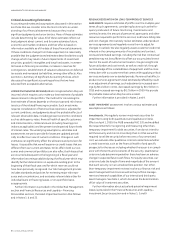GE 2011 Annual Report Download - page 58
Download and view the complete annual report
Please find page 58 of the 2011 GE annual report below. You can navigate through the pages in the report by either clicking on the pages listed below, or by using the keyword search tool below to find specific information within the annual report.’
56 GE 2011 ANNUAL REPORT
Our loss mitigation strategy is intended to minimize economic
loss and, at times, can result in rate reductions, principal forgive-
ness, extensions, forbearance or other actions, which may cause
the related loan to be classifi ed as a Troubled Debt Restructuring
(TDR), and also as impaired. Changes to Real Estate’s loans primar-
ily include maturity extensions, principal payment acceleration,
changes to collateral terms and cash sweeps, which are in addi-
tion to, or sometimes in lieu of, fees and rate increases. The
determination of whether these changes to the terms and con-
ditions of our commercial loans meet the TDR criteria includes
our consideration of all relevant facts and circumstances. At
December 31, 2011, TDRs included in impaired loans were
$13.7 billion, primarily relating to Real Estate ($7.0 billion), CLL
($3.6 billion) and Consumer ($2.9 billion).
Real Estate TDRs increased from $4.9 billion at December 31,
2010 to $7.0 billion at December 31, 2011, primarily driven by
loans scheduled to mature during 2011, some of which were
modifi ed during 2011 and classifi ed as TDRs upon modifi ca-
tion. For borrowers with demonstrated operating capabilities,
we work to restructure loans when the cash fl ow and projected
value of the underlying collateral support repayment over the
modifi ed term. We deem loan modifi cations to be TDRs when we
have granted a concession to a borrower experiencing fi nancial
diffi culty and we do not receive adequate compensation in the
form of an effective interest rate that is at current market rates
of interest given the risk characteristics of the loan or other con-
sideration that compensates us for the value of the concession.
For the year ended December 31, 2011, we modifi ed $4.0 billion
of loans classifi ed as TDRs, substantially all in our Debt portfolio.
Changes to these loans primarily included maturity extensions,
principal payment acceleration, changes to collateral or covenant
terms and cash sweeps, which are in addition to, or sometimes
in lieu of, fees and rate increases. The limited liquidity and higher
return requirements in the real estate market for loans with
higher loan-to-value (LTV) ratios has typically resulted in the con-
clusion that the modifi ed terms are not at current market rates
of interest, even if the modifi ed loans are expected to be fully
recoverable. We received the same or additional compensation in
the form of rate increases and fees for the majority of these TDRs.
Of our modifi cations classifi ed as TDRs in the last twelve months,
$0.1 billion have subsequently experienced a payment default.
The substantial majority of the Real Estate TDRs have reserves
determined based upon collateral value. Our specifi c reserves
on Real Estate TDRs were $0.6 billion at December 31, 2011 and
$0.4 billion at December 31, 2010, and were 8.4% and 8.9%,
respectively, of Real Estate TDRs. Although we experienced an
increase in TDRs over this period, in many situations these loans
did not require a specifi c reserve as collateral value adequately
covered our recorded investment in the loan. While these modi-
fi ed loans had adequate collateral coverage, we were still required
to complete our TDR classifi cation evaluation on each of the mod-
ifi cations without regard to collateral adequacy.
We utilize certain short-term (three months or less) loan modi-
fi cation programs for borrowers experiencing temporary fi nancial
diffi culties in our Consumer loan portfolio. These loan modifi cation
programs are primarily concentrated in our non-U.S. residential
mortgage and non-U.S. installment and revolving portfolios. We
sold our U.S. residential mortgage business in 2007 and as such,
do not participate in the U.S. government-sponsored mortgage
modifi cation programs. For the year ended December 31, 2011, we
provided short-term modifi cations of approximately $1.0 billion
of consumer loans for borrowers experiencing fi nancial diffi cul-
ties, substantially all in our non-U.S. residential mortgage, credit
card and personal loan portfolios, which are not classifi ed as TDRs.
For these modifi ed loans, we provided insignifi cant interest rate
reductions and payment deferrals, which were not part of the
terms of the original contract. We expect borrowers whose loans
have been modifi ed under these short-term programs to continue
to be able to meet their contractual obligations upon the conclu-
sion of the short-term modifi cation. In addition, we have modifi ed
$2.0 billion of Consumer loans for the year ended December 31,
2011, which are classifi ed as TDRs. Further information on
Consumer impaired loans is provided in Note 23.
Delinquencies
For additional information on delinquency rates at each of our
major portfolios, see Note 23.
























